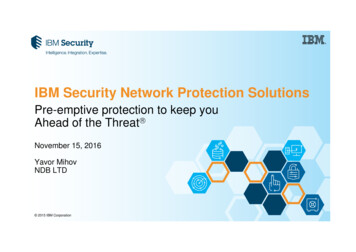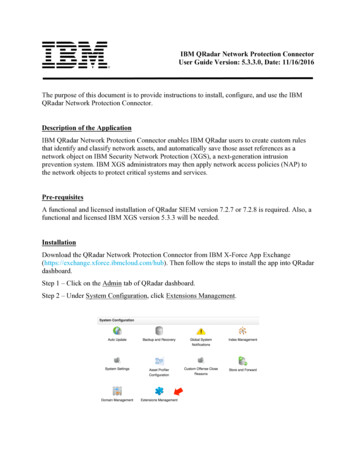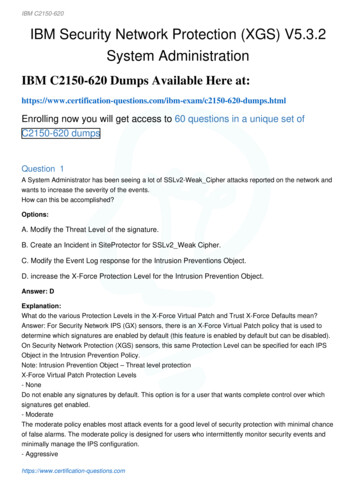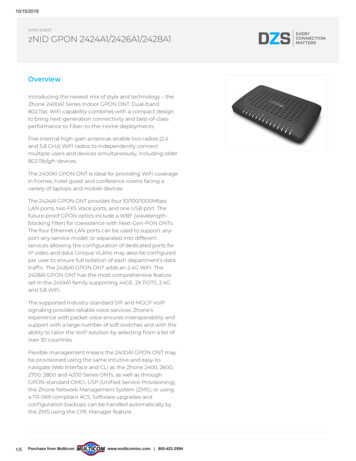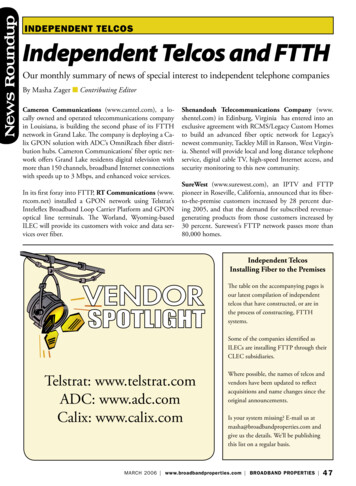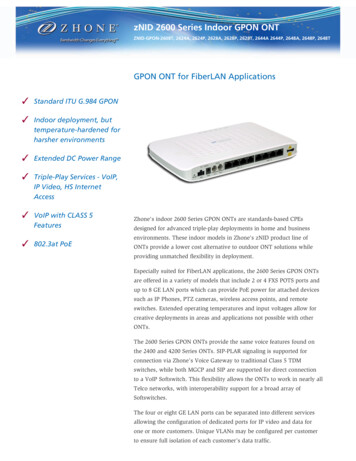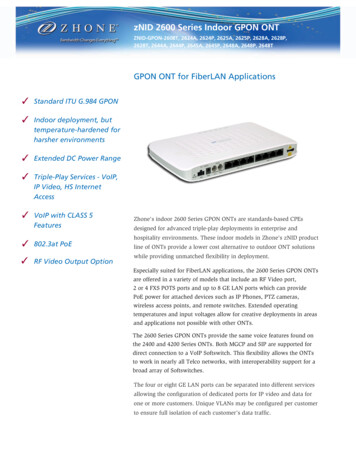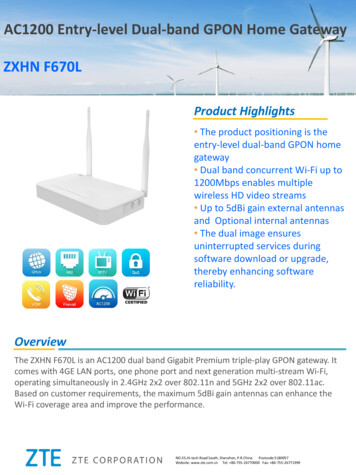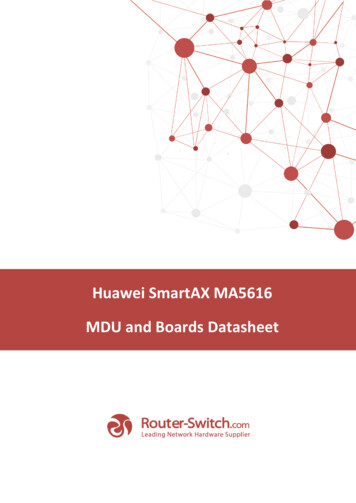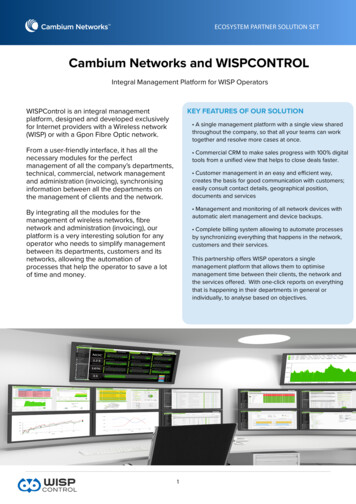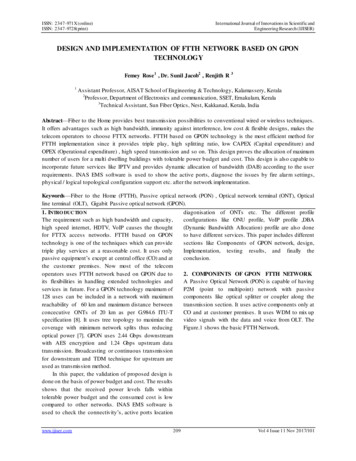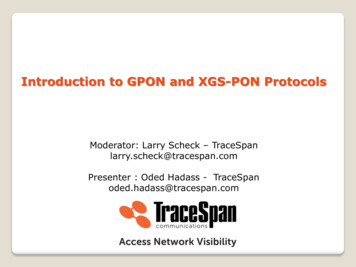
Transcription
Introduction to GPON and XGS-PON ProtocolsModerator: Larry Scheck – TraceSpanlarry.scheck@tracespan.comPresenter : Oded Hadass - TraceSpanoded.hadass@tracespan.com
Agenda (1 hour) Webinar Introduction Introduction to the GPON protocol Introduction to XG-PON and XGS-PON GPON and XGS-PON Comparison Questions2 TraceSpan Communications
Agenda (1 hour) Webinar Introduction Introduction to the GPON protocol Introduction to XG-PON and XGS-PON GPON and XGS-PON Comparison Questions3 TraceSpan Communications
IntroductionTraceSpan has for over 18 yearsbeen in the business of providingnon-intrusive access troubleshootingand analysis tools.For more than ten years Oded Hadass has been theDirector of Product Management for TraceSpan’sportfolio of GPON, NG-PON, G.fast and xDSL testproducts.Oded’s vast expertise in access technologies enableshim to support both service providers and vendors insolving their own technical challenges.4 TraceSpan Communications
Agenda (1 hour) Webinar Introduction Introduction to the GPON protocol Introduction to XG-PON and XGS-PON GPON and XGS-PON Comparison Questions5 TraceSpan Communications
Introduction to the GPON Protocol GPON Transmission Basics – Downstream andUpstream AES Encryption ONU Activation Process GPON Network Hierarchy – T-CONTs and GEM Ports Control Messages6 TraceSpan Communications
Passive Optical Networks (PON) Passive point-to-multipoint infrastructure A single fiber and a single OLT interface to serve multiple ONUs Passive (unpowered) optical splittersONUONU1 FiberONUOLTPassive SplittersONU7 TraceSpan CommunicationsTypically32/64/128
GPON Highlights Support for asymmetric line rate operation, 2.488 Gbit/s D/S and1.244 Gbit/s U/S rates Downstream wavelength 1490 nm Upstream wavelength 1310 nm Option for “RF” Video overlay: wavelength 1550 nm Up to 128 ONUs per fiber tree but 32 or 64 is more typical. 28 dB optical budget to support 20 km reach and 1:32 split ratio First standards published in 2003-2004 by ITU-T, currentstandards are from 2014Wavelength (nm)8 TraceSpan Communications
GPON Transmission Basics – Downstream Point to Multi-Point Every ONU gets all the transmissions Security addressed by AES (Advanced Encryption Standard, 128-bit key)ONU 1ABCONU 2OLTONU 39 TraceSpan Communications
Optical Signal Flow and Isolation//////////Tom////HarryDue to the physics of thenetwork, Harry’s data flowsupstream but does notcome to Tom’s box, so Tomcannot see Harry’s data10 TraceSpan Communications
GPON Security Threat Model The basic concern in PON is that the downstream data is broadcast to all ONUsattached to the PON – if a malicious user were to re-program his ONU, then themalicious user could listen to all the downstream data of all the users Other, more exotic threats are notconsidered practically important –require more resources than itwould be worthAONU 1BCOLTONU 211 TraceSpan Communications
AES Encryption1.The OLT initiates the process – requests a key from the ONU2.The ONU generates the key and sends it to the OLT3.The OLT defines the Key Switching Time and the encrypted ports andnotifies the ONUONU 1ONU 2OLTONU 312 TraceSpan Communications
AES Encryption1.The OLT initiates the process – requests a key from the ONU2.The ONU generates the key and sends it to the OLT3.The OLT defines the Key Switching Time and the encrypted ports andnotifies the ONUONU 1ONU 2OLTONU 313 TraceSpan Communications
AES Encryption1.The OLT initiates the process – requests a key from the ONU2.The ONU generates the key and sends it to the OLT3.The OLT defines the Key Switching Time and the encrypted ports andnotifies the ONUONU 1ONU 2OLTONU 314 TraceSpan Communications
GPON Encryption Messages – Example15 TraceSpan Communications
GPON Transmission Basics - Upstream TDMA (Time Division Multiple Access) mechanism: The OLT assigns timeslots (BWmaps) for every ONU to transmit its upstream transmissions toensure collision-free transmission During the ONU activation process, the OLT assigns an Equalization Delay to each ONU tocompensate for different distances from the OLT, meaning different delays The “Quiet Window” allows new ONUsto join the PONAOLTBCThe timeslotassignments ensure thatall upstreamtransmissions arealignedAONU 1BONU 2CONU 316 TraceSpan Communications
ONU Activation ProcessDefined in G.984.3, clause A.6 and Figure A.5 Defines a state machine with 5 states: Initial state (O1)Standby state (O2)Serial Number state (O3)Ranging state (O4)Operation state (O5)Notes:1. The ONU Bring-up process includes the ONU activation process,followed by some OMCI message exchange. It is described in G.988 andwill be covered separately later on.2. There are two additional states that the ONU can transition to, but arenot part of the activation – POPUP state (O6) and Emergency Stop State(O7)17 TraceSpan Communications
Important Terms PSync Physical Synchronization – a fixed 32-bit pattern (0xB6AB31E0) thatbegins every downstream frame The ONU uses this pattern to find the beginning of the frame Preamble and Delimiter Each upstream burst begins with the upstream physical layer overhead(PLOu) section which is composed of preamble, delimiter and the 3-byteburst header The preamble is used to identify the start of the upstream burst at thephysical layer, the delimiter identifies the start of the frame at the GTC(MAC) layer18 TraceSpan Communications
ONU Activation Process –Full Activation Process Flow Diagram19 TraceSpan Communications
ONU Activation Process – States O1, O220 TraceSpan Communications
ONU Activation Process – State O321 TraceSpan Communications
ONU Activation Process – States O3, O4, O522 TraceSpan Communications
ONU Activation Process – Example23 TraceSpan Communications
Traffic Containers (T-CONT) T-CONT: A grouping of logical connections for the purpose of upstreambandwidth assignment Definition from TR-156: A traffic-bearing object within an ONU that represents a group of logicalconnections, is managed via the ONU Management and Control Channel (OMCC), and is treatedas a single entity for the purpose of upstream bandwidth assignment on the PON 5 T-CONT types are defined in ITU-T G.984.3 Type 1 Fixed bandwidth Type 2 Assured bandwidth Type 3 Assured & Non-Assured bandwidth Type 4 Best effort Type 5 Fixed, Assured and Non-Assured24 TraceSpan Communications
Bandwidth Assignments for T-CONTs TDMA (Time Division Multiple Access) mechanism: The OLT assigns timeslots (BWmaps) for every ONU to transmit its upstream transmissions, Every BWmap assigment includes the T-CONT ID (Alloc-ID)T-CONT (1)AAOLTBCT-CONT (1001)EONU 1BFT-CONT (2)EONU 2T-CONT (3)The timeslot assignmentsensure that all upstreamtransmissions are alignedCT-CONT (3001)FONU 325 TraceSpan Communications
Downstream BWmaps and Upstream Frames26 TraceSpan Communications
BWmaps and Corresponding Upstream Transmissions27 TraceSpan Communications
Dynamic Bandwidth Allocation (DBA) Not all users and all services need all their peak bandwidth allthe time Fixed bandwidth allocations are inefficient Dynamic bandwidth allocation is needed to optimizebandwidth usage of the shared medium With DBA, the OLT assesses the bandwidth needs of all ONTs andallocates available bandwidth dynamically Allows service providers to define flexible service options,oversubscription levels and Service Level Agreements28 TraceSpan Communications
GPON Encapsulation Method (GEM) andMultiplexing Model GEM is a method forencapsulating userframe data fortransport over theGPON “GEM ports” representa logical connectionassociated with aspecific traffic flow29 TraceSpan Communications
Control Messages Physical layer OAM (PLOAM) messaging channel Supports the PON TC layer management functions, including ONUactivation/deactivation, OMCI channel establishment, encryptionconfiguration and key management Transported in the 13-byte PLOAM message field within the overhead section ofthe downstream GTC frame and default Alloc-ID of the upstream GTC burst Specified in ITU-T G.984.3 ONU management and control interface (OMCI) OMCI messages are transported over a dedicated GEM channel. The OMCItransport mechanism is described in ITU-T G.984.3 clause 14 The syntax of the OMCI is specified in ITU-T G.98830 TraceSpan Communications
Agenda (1 hour) Webinar Introduction Introduction to the GPON protocol Introduction to XG-PON and XGS-PON GPON and XGS-PON Comparison Questions31 TraceSpan Communications
Introduction to XG-PON and XGS-PON History and Market Drivers Technology and Protocol Highlights Burst Profiles and Dual-Rate Support32 TraceSpan Communications
Beyond GPON – Main Market Drivers Competition Business services Backhaul for 4G and 5G wireless networks33 TraceSpan Communications
XG-PON1, XGS-PON and NG-PON2 Definitions andStandardization History2011XG-PON1ITU n (FSAN)2015NG-PON2ITU Standards(G.989.x)2016XGS-PONITU Standard(G.9807.1)34 TraceSpan Communications
XG-PON1 – Highlights Downstream 10 Gb/s (9.95328 Gb/s) Upstream 2.5 Gb/s (2.48832 Gb/s) Other major enhancements compared to GPON: 29 dB optical budget Split ratio up to 1:256 Extended power saving modes Enhanced security35 TraceSpan Communications
XG-PON1 – Framing and TDMA Control Reuse and adaptation of the GPON protocol More flexible PLOAM channel Multiple messages in the same frame Extended PLOAM message length – 48 bytes compared to 13 bytes inGPON Expansion of fields36 TraceSpan Communications
Example – Multiple PLOAM Messages in One FramePLOAM MessageNo. 1PLOAM MessageNo. 237 TraceSpan Communications
XGS-PON – Highlights Downstream 10 Gb/s (9.95328 Gb/s) Upstream 10 Gb/s (9.95328 Gb/s) or 2.5 Gb/s (2.48832Gb/s) – support for two types of ONUs on the same PON Protocol and frame structure similar to XG-PON1, butminor differences38 TraceSpan Communications
XGS-PON – Profiles and Dual Rate Support The Burst Profile PLOAM message specifiesparameters for upstream transmission, including: The upstream line rate – 10 Gb/s or 2.5 Gb/s The Preamble and Delimiter If FEC is to be used in the upstream There may be several different profilessimultaneously on the PON, each with its own index Each BWmap allocation specifies the profile index forthe upstream transmission39 TraceSpan Communications
XGS-PON – Profiles and Dual Rate Support The same index may be used for two burst profilessimultaneously, one for 10 Gb/s upstream and the secondfor 2.5 Gb/s upstream The Quiet Window BWmap specifies which type of ONUsshould respond using a different broadcast Alloc-ID: Alloc-ID 1022: ONUs transmitting at 10 Gb/s Alloc-ID 1023: ONUs transmitting at 2.5 Gb/s Alloc-ID 1021: Both types of ONUs (shall not be used for the caseof XGS-PON interworking with XG-PON1)40 TraceSpan Communications
XGS-PON Quiet Window BWmap(“Serial Number Grant”) ExampleBurst Profile IndexAlloc-ID 1022 – for ONUstransmitting at 10Gb/s TraceSpan Communications
Agenda (1 hour) Webinar Introduction Introduction to the GPON protocol Introduction to XG-PON and XGS-PON GPON and XGS-PON Comparison Questions42 TraceSpan Communications
GPON and XGS-PON Comparison Frame and BWmap Structure Wavelength Assignment PON-ID ONU-ID, Alloc-ID and Port ID Value Ranges Security Threats and Mechanisms43 TraceSpan Communications
XG-PON1/XGS-PON – BWmap Structure In GPON the BWmap specifies the Start Time and Stop Time for the burst, in XG-PON1/XGS-PON – theStart Time and Grant Size Every XG-PON1/XGS-PON BWmap also specifies the Burst Profile as one of its flags, other flags are alsoslightly different44 TraceSpan Communications
Wavelength AssignmentWavelength(or Range)Usage1270 nmXG-PON1/XGS-PON US1310 nmGPON US1490 nmGPON DS1524-1544 nmNG-PON2 (TWDM) US1550 nmAnalog (“RF”) Overlay DS1577 nmXG-PON1/XGS-PON DS1596-1603 nmNG-PON2 (TWDM) DS1603-1625 nmNG-PON2 (PtP WDM) SharedSpectrum DS and US45 TraceSpan Communications
PON-ID A typical fiber distribution panel orcabinet has hundreds or even thousandsof connections, how can you tell whichfiber belongs to which PON? The PON-ID provides a uniqueidentification to every PON Mandatory in XG-PON1/XGS-PON, alsoadded as an amendment to the GPONstandard (included in the 2014 version ofG.984.3), but defined as optional In XG-PON1 and XGS-PON it is part of thedownstream frame, in GPON a separatePLOAM message46 TraceSpan Communications
ONU-ID nComment0.2530.10220.1020AssignableAssigned by OLT at ONU activation;used to identify the sender of anupstream burst or a PLOAMumessage and the recipient of aPLOAMd message.1021ReservedThe number shall not be assignedto any ONU, and shall not be usedas an ONU-ID.1022Broadcast/reservedBroadcast address in PLOAMd; notused in PLOAMu.The number shall not be assignedto any ONU, and shall not be usedas an ONU-ID.1023Broadcast/unassigned2542551023Broadcast address in PLOAMd;unassigned ONU in PLOAMu.47 TraceSpan Communications
Alloc-ID ignationComment0.2530.10220.1020DefaultDefault Alloc-ID, which is implicitlyassigned with and is equal to the ONUID.2541023102110221023Reserved/BroadcastUsed by OLT in a serial number requestallocation structure to indicate that anyONU* executing the serial numberacquisition phase of the activationprocedure may use this allocation totransmit a serial number May be used by the OLT to indicatethat a particular allocation structureshould not be used by any ONU.AssignableIf more than a single Alloc-ID isneeded for an ONU, the OLT assignsadditional Alloc-IDs to that ONU byselecting a unique number from thisrange and communicating it to theONU using the Assign Alloc-ID PLOAMmessage.* In XGS-PON different Broadcast Alloc-IDs are used for ONUs transmitting atdifferent upstream rates48 TraceSpan Communications
Port-ID DDesignationComment0.10220.1020DefaultDefault XGEM Port-ID, which isimplicitly assigned with and is equalto the ONU-ID. It identifies theXGEM port used by the OMCCtraffic.1023.655341021.65534AssignableIf more than a single XGEM Port-IDis needed for an ONU, the OLTassigns additional Port-IDs to thatONU by selecting a unique numberfrom this range and communicatingit to the ONU using the OMCC.In XGS-PON The values 1021 and1022 shall not be assigned to XGPON ONUs.6553565535IdleReserved for Idle XGEM Port-ID.49 TraceSpan Communications
XG-PON1/XGS-PON – Security (1) XGS-PON security is intended to protect against the following threats: Since downstream data is broadcast to all ONUs attached to the OLT, a malicioususer capable of replacing or re-programming an ONU would be capable ofreceiving all downstream data intended for all connected usersONU 1ABCOLTONU 250 TraceSpan Communications
XG-PON1/XGS-PON – Security (2) XGS-PON security is intended to protect against the following threats(continued): Since upstream data received by the OLT can originate from any ONU attached tothe XGS-PON optical distribution network (ODN), a malicious user capable ofreplacing or re-programming an ONU could forge packets so as to impersonate adifferent ONU (i.e., theft of service)AAOLTBCONU 1BCONU 351 TraceSpan Communications
XG-PON1/XGS-PON – Security (3) XGS-PON security is intended to protect against the following threats(continued): An attacker could connect a malicious device at various points on theinfrastructure (e.g., by tampering with street cabinets, spare ports, or fibercables). Such a device could intercept and/or generate traffic. Depending on thelocation of such a device, it could impersonate an OLT or alternatively it couldimpersonate an ONUONU 1ONU 2OLTONU 352 TraceSpan Communications
XG-PON1/XGS-PON – Security (4) XGS-PON security is intended to protect against the followingthreats (continued): A malicious user in any of the above scenarios could record packetstransmitted on the PON and replay them back onto the PON later, orconduct bit-flipping attacksONU 1ONU 2OLTONU 353 TraceSpan Communications
XG-PON1/XGS-PON Security – AES Encryption Unlike GPON that supports AES encryption only in the downstreamdirection, XGS-PON also supports it in the upstream AES encryption is optional In the downstream it is more commonly used than in the upstream XGS-PON supports two keys simultaneouslyONU 1ONU 2OLTONU 354 TraceSpan Communications
XGS-PON AES Encryption ExampleThe XGEM Header Key Index indicates which key is used for encryptionKey Index 0 indicates no encryption55 TraceSpan Communications
XG-PON1/XGS-PON –Additional Security Mechanisms Authentication – the XG-PON1/XGS-PON systems supportsthree mechanisms for authentication: Registration-based authentication OMCI-based secure mutual authentication IEEE 802.1X-based authentication secure mutual authentication MIC – the message integrity check is an 8-byte field that isused to verify the sender's identity and to prevent a forgedPLOAM message attack56 TraceSpan Communications
TraceSpan Products LabXpert Analyzers and Emulators NG-PON Xpert Multi-layer analyzer Multi-ONU Emulator OLT Emulator GPON Xpert Multi-layer analyzer OLT EmulatorGPON Tracer Field GPON Tracer 57 TraceSpan Communications
Agenda (1 hour) Introduction Introduction to the GPON protocol Introduction to XG-PON and XGS-PON GPON and XGS-PON Comparison Questions58 TraceSpan Communications
Questions59 TraceSpan Communications
Thank you for attendingIf you would like additional informationabout TraceSpan products:www.tracespan.cominfo@tracespan.com60 TraceSpan Communications
TraceSpan Communications GPON Highlights Support for asymmetric line rate operation, 2.488 Gbit/s D/S and 1.244 Gbit/s U/S rates Downstream wavelength 1490 nm Upstream wavelength 1310 nm Option for "RF" Video overlay: wavelength 1550 nm Up to 128 ONUs per fiber tree but 32 or 64 is more typical. 28 dB optical budget to support 20 km reach and 1:32 split ratio
